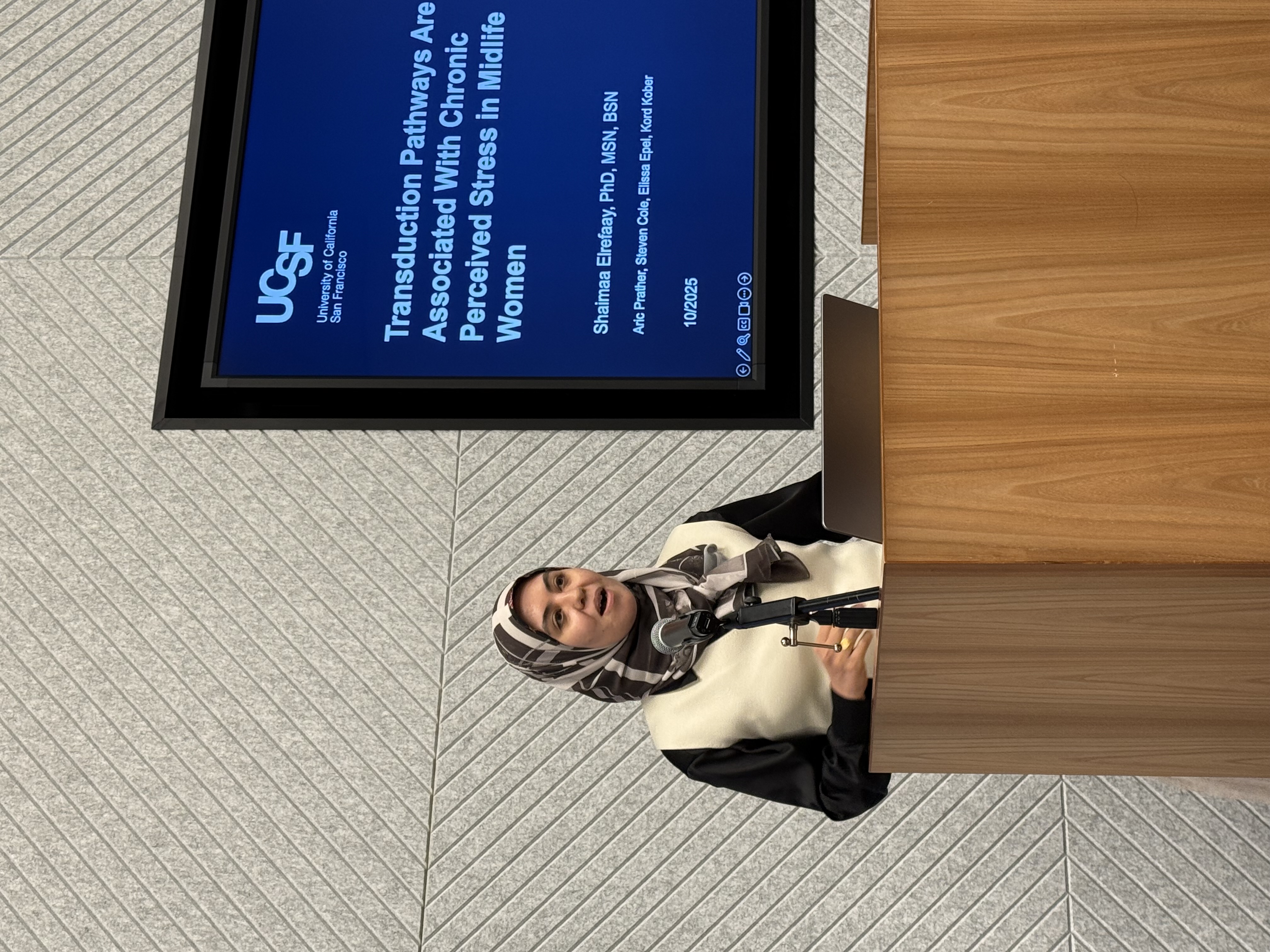 Dr. Shaimaa Elrefaay is a postdoctoral researcher with UCSF’s Departments of Epidemiology & Biostatistics and Psychiatry & Behavioral Sciences. Her research examines the complex interplay between epigenetic mechanisms and mental health outcomes, with a particular focus on early life stress and vulnerable populations. She earned her Ph.D. in Nursing from UCSF, where her work explored the multifaceted factors contributing to mental health disparities among minority populations.
Dr. Shaimaa Elrefaay is a postdoctoral researcher with UCSF’s Departments of Epidemiology & Biostatistics and Psychiatry & Behavioral Sciences. Her research examines the complex interplay between epigenetic mechanisms and mental health outcomes, with a particular focus on early life stress and vulnerable populations. She earned her Ph.D. in Nursing from UCSF, where her work explored the multifaceted factors contributing to mental health disparities among minority populations.
We spoke with her about her research in the biopsychosocial model of stress, mental health risk factors and interventions for Arab-American communities, and future career aspirations.
Can you share more about your work at the intersection on nursing and behavioral science?
I have a distinctive combination of a nursing background with a behavioral health focus. My passion for mental health started while pursuing my master’s degree specializing in psychiatric and mental health nursing, with a growing research agenda focused on examining stress and related mental health outcomes among vulnerable populations. Nursing science instilled the seed for a patient-centered, compassionate clinical and research endeavor, which further fueled my curiosity to learn more about stress and mental health problems. This passion is directed toward integrating psychosocial underpinnings with biological mechanisms, such as epigenetics and telomere biology, to map out the onset and progression of stress-related and mental health disorders. Ultimately, my work aims to bridge clinical practice with scientific innovation and translate the bio-psychosocial findings into applicable strategies for mental health promotion at large-scale levels.
Could you elaborate on your work in the field of epigenetics?
My passion for epigenetics research sprouted during my doctoral nursing study and further solidified during my current postdoctoral position, particularly in the context of stress and its role in modulating these biological processes. I am developing a deeper understanding of the literature on the role of stress-related epigenetic modifications (e.g., DNA methylation, epigenetic clocks, and telomere length) in the onset and progression of stress-related and mental health disorders. I’m presently working on two projects that examine how gene-environment interactions, particularly those involving psychosocial stress, influence epigenomic processes of telomere attrition and the Horvath epigenetic clock to predict biomarkers of risk, offering a novel approach for risk assessment in aging and cancer outcomes. The findings from these projects will contribute to advancing our understanding of the biological mechanisms underlying stress-related epigenetic alterations and their implications for cellular aging and health disparities.
Could you share more about your publication, Depression and Anxiety Among Arab Individuals in the United States: A Meta-Analysis? What unique risk factors for depression and anxiety have you identified within Arab American communities?
My recent publication highlighted a clear gap in the Arab minority population regarding the pooled level of depression and anxiety and their moderated socio-demographic factors. The high prevalence rates for depression and anxiety identified through this meta-analysis are very concerning and underscore the urgent need to address mental health concerns in Arab communities. Results of subgroup and meta-regression analyses suggest that refugees, individuals from specific countries of origin, and younger Arabic persons may need particular attention by clinicians in screening for and treating their depression and anxiety. In another of our systematic reviews, we identified several key factors that significantly impacted the mental health of Arab individuals living in the U.S. These factors include being female, being older, experiencing perceived discrimination, and facing immigration-related challenges, particularly for refugees and immigrants who arrived in the U.S. during or prior to their early adolescence. Risk factors identified through this review can provide focal points for mental health assessment, prevention, and culturally appropriate intervention as well as for further research. Our results also signify the need for further high-quality studies to more rigorously assess the prevalence of these mental health problems, since we found evidence of potential publication bias and approximately one-third of the studies in the review had less optimal methodological quality based on our evaluation. Ultimately, in-depth research regarding the causes of anxiety or depression among Arab individuals will be essential to the development of culturally competent interventions that may reduce their very high prevalence rates.
What suggestions do you have for policymakers and clinicians to better address the mental health needs of Arab American communities?
These research findings clearly underscore several noteworthy clinical and policy implications. Mental health clinicians can be sensitized to the potential increases in vulnerability of certain Arab subpopulations, including females, older adults, refugees, and those with less education. An example of simultaneously addressing more than one of these risk factors might involve the provision of gender-sensitive and age-appropriate mental health services and support groups, which in turn may provide a safe space for Arab immigrants to discuss their concerns and access appropriate resources. Trauma-informed interventions can be directed at forced emigrants and refugees, given their larger risk for mental health issues. Understanding the influence of perceived discrimination, acculturation stress, and social support on the mental health of immigrants and refugees, especially Arabs, might assist in formulating treatments to target these stressors as well as foster resilience within the community. Risk factor interconnectedness and how these risks impact diverse mental health outcomes emphasize the significance of implementing a comprehensive and personalized approach to treatment, including support services. Policymakers may focus on funding culturally competent mental health programs catering to the varied needs of the Arabs living in the U.S. Additionally, policymakers should spotlight efforts to bolster the role of families within immigrant communities; this involves developing programs to engage the community, fostering initiatives that enhance cultural integration, and providing resources for mental health support. Such a collaborative approach will enable the early identification of those in need of mental health services and the potential dissolution of the pathway to emotional distress among vulnerable Arabs.
What’s next for you in your work? What topics do you hope to delve into more deeply?
I aim to complement my postdoctoral work by further investigating the epigenetic modifications associated with stress resilience or susceptibility to biological aging and depression risk in women and vulnerable populations. I’m interested in integrating advanced molecular techniques, biomarker analysis, and intervention research to address critical gaps in understanding how stress-reduction interventions impact biological aging processes. Ultimately, I aspire to be in a tenure-track faculty position where I can pursue impactful research ideas and collaborate with experts in leading translational research on interventions targeting stress-related biological aging. I wish to mentor future researchers, especially those in nursing and behavioral sciences and those who are from disadvantaged backgrounds, to contribute to the discipline and profession of nursing science, which takes an integrative and interdisciplinary perspective in addressing complex challenges in stress, molecular aging, and mental health.
Read Dr. Elrefaay's publication here.
A note from Dr. Elrefaay:
 I immigrated from Egypt with my family to pursue advanced science and greater educational opportunities for a better future. Throughout this journey, I have encountered many personal, social, and professional challenges that have profoundly influenced our lives. As a woman with young children who was determined to pursue graduate education while supporting my family, I faced the difficulty of balancing competing responsibilities. In addition, the cultural dissimilarities and the process of adapting to a new environment placed a significant burden on me as I navigated how to maintain my identity while integrating into a different society. As a provider in skilled nursing, long-term care, and community health clinics, I faced many challenges firsthand. Balancing long shifts with raising young children, adapting to new clinical systems, and overcoming cultural differences often made it difficult to pursue higher education. Yet these obstacles strengthened my resilience and deepened my commitment to advancing my career. I pursued my PhD at UCSF to study the biological and social underpinnings of stress, with a strong passion for addressing stress-related problems, mental health challenges in women, and the role of epigenetics in shaping health outcomes. Building on this foundation, I continued my training as a postdoctoral researcher at UCSF, where I expanded my work on gene-environment interactions, epigenetic markers, and women’s health, furthering my commitment to bridging science and clinical care. As a nursing scientist and clinician, I would suggest that Arab immigrant communities need mental health providers who truly understand their culture and language. Stigma often prevents families from seeking help, so outreach through mosques and community centers can create safe entry points to care. Policymakers should also collect better data on Arab immigrants, so their unique needs are not overlooked. At the same time, clinicians must approach care with sensitivity, recognizing the central role of family, faith, and trust. Finally, making services more affordable and accessible is essential to reducing barriers and promoting equity in mental health care.
I immigrated from Egypt with my family to pursue advanced science and greater educational opportunities for a better future. Throughout this journey, I have encountered many personal, social, and professional challenges that have profoundly influenced our lives. As a woman with young children who was determined to pursue graduate education while supporting my family, I faced the difficulty of balancing competing responsibilities. In addition, the cultural dissimilarities and the process of adapting to a new environment placed a significant burden on me as I navigated how to maintain my identity while integrating into a different society. As a provider in skilled nursing, long-term care, and community health clinics, I faced many challenges firsthand. Balancing long shifts with raising young children, adapting to new clinical systems, and overcoming cultural differences often made it difficult to pursue higher education. Yet these obstacles strengthened my resilience and deepened my commitment to advancing my career. I pursued my PhD at UCSF to study the biological and social underpinnings of stress, with a strong passion for addressing stress-related problems, mental health challenges in women, and the role of epigenetics in shaping health outcomes. Building on this foundation, I continued my training as a postdoctoral researcher at UCSF, where I expanded my work on gene-environment interactions, epigenetic markers, and women’s health, furthering my commitment to bridging science and clinical care. As a nursing scientist and clinician, I would suggest that Arab immigrant communities need mental health providers who truly understand their culture and language. Stigma often prevents families from seeking help, so outreach through mosques and community centers can create safe entry points to care. Policymakers should also collect better data on Arab immigrants, so their unique needs are not overlooked. At the same time, clinicians must approach care with sensitivity, recognizing the central role of family, faith, and trust. Finally, making services more affordable and accessible is essential to reducing barriers and promoting equity in mental health care.



